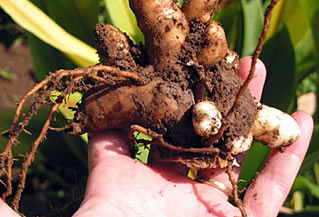|
15 October 2025
|
|
|
മലയാളം
|
|
|
|
|
|
Agriculture > Spices
> Turmeric (Curcuma longa)
|
|
|
|
Origin
Turmeric (Curcuma longa) is native to Asia and India. The tuberous
rhizomes or underground stems of turmeric are used from antiquity as condiments,
a dye and as an aromatic stimulant in several medicines. Presently, it is
cultivated in India, China, Taiwan, Indonesia, Sri Lanka, Australia, Africa, Peru
and the West Indies. Turmeric usage dates back nearly 4000 years, to the Vedic
culture in India, when turmeric was the principal spice and also of religious significance.
It is much revered by Hindus and associated with fertility. In today's India,
turmeric is still added to nearly every dish, be it meat or vegetables. Turmeric
has been used in Indian systems of medicine for a long time.
Characteristics
Growth habit
|
Turmeric is a herbaceous perennial with a rhizome from which arises tufts of large,
broad, lanceolate, bright green leaves acute at both ends. The plant grows
up to 60 to 90 cm high. Leafy shoots are erect; bearing 6-10 leaves with the
leaf sheath forming a pseudostem. The ligule is a small lobe (1mm long).
The sheath near the ligule has ciliate margins.
|

|
Flowers

|
The inflorescence is a cylindrical spike, 10-55 cm long, and 5-7 cm wide and terminal
on the leafy shoot. The flowers are yellow or pale yellow, borne in a spike.
They arise from two buds situated in the axils of bracts and mature successively.
Bracts are greenish-white; the uppermost tinged with pink. The bracteoles
are thin and elliptic. The calyx is short, unequally toothed and split nearly
half way down on one side. The corolla is tubular at the base and the upper
half is cup-shaped. There are two lateral staminodes. The lip or labellum
is obovate. The ovary is inferior and trilocular with a slender style held
by anther lobes and passing between them. Fruits are seldom.
|
Rhizome
|
The primary tuber at the base of the aerial stem is ellipsoidal bearing many rhizomes;
straight or little curved, with secondary branches in two rows and further tertiary
branches, the whole forming a dense clump. Rhizomes have a distinctive taste
and smell, brownish and scaly outside and the inside is bright orange in colour.
The roots are fleshy, often ending in a swollen starchy tuber.
|

|
|
|
|
|
Top
|
|
|
|
|
|